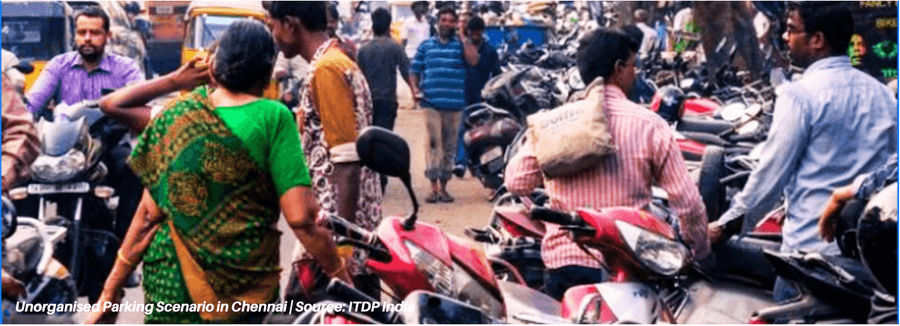Chennai Parking Policy Highlights - 2025
March 27, 20253 minsThis article is a summary of CUMTA’s ‘Parking Policy for CMA’ [PDF] which presents the comprehensive Parking Policy and Strategy & Action Plan for the Chennai Metropolitan Area (CMA), approved by the Government of Tamil Nadu in January 2025.
Context & Need
- Chennai’s population (14.5 million in 2023) and vehicle population (9.2 million in 2022) have grown substantially
- Rapid urbanization has led to inadequate public transport and proliferation of private vehicles
- Unregulated parking causes congestion, footpath encroachment, and inefficient use of valuable urban space
Vision & Guiding Principles
The policy aims to transform Chennai into an urban space with organized, optimized parking that:
- Treats parking as a valuable real estate resource (not a free right)
- Creates active, pedestrian-friendly streets
- Optimizes freight and bus terminal parking
- Ensures curb management with prioritization of public transit
- Facilitates EV adoption through charging infrastructure
- Leverages technology for better management
- Ensures universal accessibility
- Enhances last-mile connectivity around transit stations
Key Strategies
- Policy Framework Integration
Integrates parking management with Master Plans and Building Regulations Incorporates a four-fold approach: Planning & Design, Pricing & Enforcement, and Reinvestment
- Planning & Design
Develops area-level parking management plans (3-5 sq.km areas) Establishes parking management clusters based on land use and demand Prioritizes on-street parking for bicycles, ride-sharing, and pick-up/drop-off points over private vehicles Discourages on-street parking near transit stations (within 100m) and on arterial streets
- Pricing & Enforcement
Implements variable pricing based on demand, duration, location, and time of day Prices on-street parking higher than off-street parking Shifts from post-paid to pre-paid parking model Establishes penalties for violations with enforcement by Traffic Police Introduces residential parking permit systems in congested neighborhoods Considers “proof of parking” requirements for vehicle registration
- Technology Integration
Creates a central Parking Information and Management System (PIMS) Develops mobile applications for real-time parking information Implements digital payment systems and monitoring technologies
- Reinvestment
Directs parking revenue to an Urban Transport Fund/Escrow Account Reinvests surplus for local improvements (footpaths, cycling facilities, public spaces)
- Institutional Framework
Establishes CUMTA (Chennai Unified Metropolitan Transport Authority) as the nodal agency Creates a Parking Management Unit under CUMTA Provides for Urban Local Bodies to implement through Parking Management Cells Ensures coordination between CUMTA, Urban Local Bodies, and Traffic Police
Implementation Phases
- Phase 1: Area-level parking management plan preparation and pilot testing
- Phase 2: Technology implementation and enforcement of parking rules
- Phase 3: City-wide scaling of parking management and demand management measures
The policy includes provisions for monitoring and evaluation through defined KPIs and emphasizes the role of private sector participation through incentives like land on nominal lease terms and Transferable Development Rights.RetryClaude can make mistakes. Please double-check responses.
Existing Literature & Case Studies that influenced this policy
The policy draws extensively from both Indian and international case studies to develop contextually appropriate parking management approaches for Chennai. Here’s a breakdown of the key case studies referenced and their influence on the policy:
Delhi (2019)
- Key Features: Comprehensive parking policy focusing on meeting demands, flexibility in supply, funding, technology use, and area-wise management strategies
- Influence: Chennai adopted Delhi’s approach to area-based parking management and technological integration
Surat (2018)
- Key Features: Policy aimed at “progressively reducing parking demand” and facilitating organized parking
- Influence: Chennai incorporated Surat’s demand management through pricing and public transport encouragement
Bengaluru
- Key Features: Strengthened existing policy to discourage personal vehicle use and ease road space for vehicle movement
- Key Adoption: Organized parking through market-driven supply and paid parking enforcement
Pune (2016)
- Key Features: Based on NUTP guidelines with goals of 80% public transport trips and 50% reduction in vehicle kilometers traveled by 2031
- Influence: Chennai adopted Pune’s approach to transform street parking space to public/NMT infrastructure
International Case Studies The policy examined practices from several European cities (Amsterdam, London, Copenhagen, Paris) with focus on three categories of interventions:
Pricing Mechanisms
- Curbside Charges: Implemented in all studied European cities
- Residential Permits: Adopted from European models, particularly London’s approach where permit fees are based on vehicle emissions
- Ring Fencing: Revenue earmarking for sustainable transport, borrowed from Barcelona and London models
Regulatory Measures
- Supply Caps: Influence from Hamburg, Zurich, and Budapest’s freezing of parking inventory in city centers
- Parking Maximums: Adopted from Zurich, Amsterdam, and Strasbourg’s ceiling on parking in new developments
- Transit-Based Adjustments: Reduction of parking requirements near transit, influenced by European TOD approaches
Advanced Technologies
- Electronic Guidance Systems: Influenced by Copenhagen’s systems
- Smart Meters: Adopted from Paris’s technology implementation
- Mobile Payment Systems: Influenced by multiple European cities’ digital payment approaches
Key Adoptions in Chennai’s Policy
The Chennai policy most clearly incorporates these elements from the case studies:
- Area-Level Planning: From Delhi’s zonal approach to parking management
- Differential Pricing: From European cities’ demand-based pricing models
- Revenue Reinvestment: From Barcelona and London’s ring-fencing of parking revenue
- Technology Integration: From San Francisco and Paris’s smart parking systems
- Residential Permit Systems: Influenced by European cities, particularly Munich where permits reduced car trips from 44% to 32%
- On-street Management: Physical design elements from San Francisco, Seoul, and Singapore (striped lines, bollards)
- Shared Parking: From Montgomery County and Beijing’s approach to time-sharing parking facilities
- Public-Private Partnerships: From various case studies to increase off-street parking supply
The policy shows a balanced approach, adapting successful international practices while remaining sensitive to the Indian urban context, especially drawing from recent implementations in Delhi, Bengaluru, and Pune.
